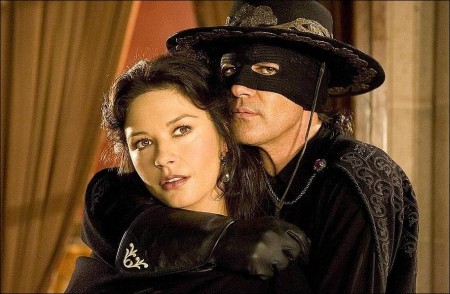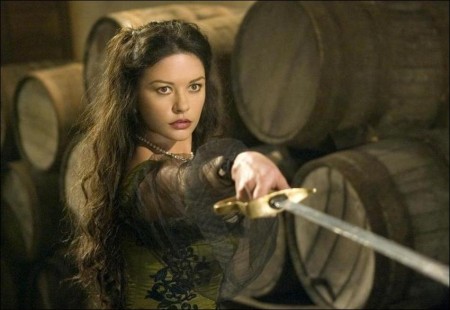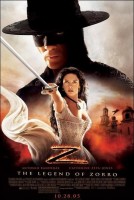The Legend of Zorro is set several years after the conclusion of the previous adventure. Alejandro (Antonio Banderas) and Elena (Catherine Zeta-Jones) are married and have a 10-year-old son, Joaquin (Adrian Alonso). Though Alejandro continues to don the mask of Zorro to protect the poor and oppressed residents of the California territory from the greed of the overlords, he is torn between his duty and his desire for a more normal life.
Now, he must face that conflict again head-on when plans for California to become the 31st state are undermined by a nefarious plot by several prominent land barons and businessmen. In his valiant attempt to foil their plans, Zorro runs headlong into a crisis that threatens his life and the safety of his family.
The year is 1850. The territory of California is seeking to become the 31st state of the union, but certain unscrupulous individuals, members of a mysterious medieval organization, are determined to prevent this event from transpiring. Once again the masked hero, Zorro, must come to the aid of the people of California so they can become citizens of the United States of America. At the same time, a corrupt robber baron McGivens (Nick Chinlund) is intimidating the law-abiding residents of California, seizing their land and threatening their livelihoods. Again, only Zorro can stop him.
Don Alejandro de la Vega, who inherited the mask of Zorro, is now married to Elena. They have a 10-year-old son, Joaquin. The boy misses his father, who is rarely at home. And when he is, Joaquin finds himself wishing that Don Alejandro behaved more like his idealized hero Zorro — having no idea that the two men are the same person.
Meanwhile, Elena forces Alejandro to choose between his family and his crusading alter ego. When an unexpected crisis forces Alejandro to once again don the mask of Zorro, Elena feels betrayed and kicks him out of the house. Soon after, she serves him with divorce papers. When a former schoolmate of Elena’s, the French aristocrat Armand (Rufus Sewell), moves to California to start a winery, he is thrilled to discover that Elena has separated from her husband. He immediately begins to woo her, while at the same time attending to his duties as the head of the Knights Of Aragon, a secret ancient fraternity. Don Alejandro now finds himself caught in a dilemma between his obligation to serve the oppressed and threatened people of California and his responsibilities as husband and father.
Zorro — The People’s Hero
Created in 1919 by Johnston McCulley for his novel, The Curse Of Capistrano, ‘Zorro’ is considered the first masked hero in modern American fiction. As The Legend of Zorro director Martin Campbell observes, “Zorro protects the common man—not many heroes before him did that. He is really a man of the people. He doesn’t have any special powers or gadgets, only a sword, a whip and his wits.” Campbell quickly adds:
“Mind you, there are some pretty extraordinary things Zorro does with those props, but ultimately he is a flesh and blood man, not a digital character like many of today’s superheroes.”
It is Zorro’s humanity that captivated producer Laurie MacDonald. “The reason I love Zorro, and think we can all relate to him more, is because he doesn’t have superhuman powers. He is an ordinary man. Sure, he rides a horse better than most and is expert at swordplay. But essentially, he is like any other man dealing with some very human issues.”
Antonio Banderas, who returns as Zorro in The Legend of Zorro, sees him as “A character who is born from the people and gives back to the people. The people need somebody and Zorro is almost like a dream come true, someone who can save them from what they see as unfair and unjust.”
The Legend of Zorro: The Saga Continues
“This new adventure takes us deeper into the story of Zorro, a true hero in the great American tradition, a man who is willing to take on the oppressor, despite the great personal risk he must endure,” says director Campbell.Part of the success of The Mask of Zorro was the adroit casting of Antonio Banderas and Catherine Zeta-Jones in the roles of Zorro and Elena. Producer Walter F. Parkes recalls: “There was just something that happened on the screen between them that really ignited.”
That spark generated over $250 million at the worldwide box office. The Legend of Zorro picks up with Zorro and Elena a decade later, married, with a child, and plunges them into a new adventure. “One of the challenges of creating the new adventure was that we married them off at the end of the last movie,” says producer MacDonald. “We pick them up a decade later, happily married, but with some serious issues between them — enough to cause a rift between them. And from this the story of Zorro and Elena’s commitment grows and deepens in an effectively dramatic way.”
The separation of Zorro and Elena in The Legend of Zorro proved to be fortuitous to the new adventure. “Love stories are always best when the status quo is upended,” says director Campbell, “when the lovers have to overcome numerous obstacles in order to be united, or in this case, reunited. And that’s precisely what happens here.”
In a way, observes producer Parkes, what happens between Zorro and Elena in The Legend of Zorro hearkens back to classic Hollywood love stories. “It’s kind of a throwback to the Hollywood comedies in which the hero and the heroine can’t live with each other — and yet, can’t live without each other either. It serves not only as a potent storytelling device, but it re-ignites the romantic energy that exists between them.”
When Banderas read the new script, he found it contained all the elements that had made the first film so satisfying. “There was comedy, which is essential to this type of movie, well developed dialogue, and lots of adventure. Knowing that Martin and many of the people who had worked on the first movie would be returning, I knew it was going to be exciting to do.”
Zeta-Jones attests, “None of us wanted to embark on a new adventure if we didn’t think it would have the same magic as the first film. When we saw that the script had captured that, well, we knew it was just a slam-dunk!”
Director Campbell found that the production of The Legend of Zorro, “Was one of those rare occasions when everybody was in agreement about what we were doing, and all of us shared in the excitement. We literally shot the final draft of the script. There were very few alterations. And that’s a rare thing indeed in movies.”
The Son Of Zorro?
Finding the right young actor to portray Zorro’s son, Joaquin, required a worldwide search including Los Angeles, London, Miami, Spain, New York and Mexico. “We had already started shooting and it came down to two kids—one very talented actor from America and Adrian Alonso,” says Parkes.
It was director Martin Campbell who finally chose the 10-year-old Mexican-born youngster, despite his limited experience (only two other movies) and the fact that he didn’t speak a word of English. Still, asserts Campbell, “I knew Adrian was the one. We narrowed it down to two boys and then sat them down separately with Antonio for a chat and we filmed it.”
Banderas recalls that “Martin said to me—‘Go out in front of the camera with the two boys and talk to them. I want you to interact with them and talk about normal things— soccer, school, acting classes.’ When I did it was also clear to me that Adrian was the one.”
Zeta-Jones is among Alonso’s biggest fans. “Martin found a little gem for the role of Joaquin. The adorable Adrian could be the next Marlon Brando if he puts his mind to it. He has that fantastic natural quality where he is not acting, he’s just being. It’s hard enough to tell an adult to just be, but with a child it is much harder. The fact that he barely speaks a word of English blows my mind as well. Martin did this kind of Marcel Marceau miming thing with him and it worked beautifully.”
Banderas echoes those sentiments, adding, “Adrian is amazing. He’s got a tremendous sense of rhythm and timing. He’s very funny and understands the film’s humor which is very off-beat for kids.”
The young actor learned his dialog phonetically working with a dialog coach, Tina French, who ran scenes with him off-screen. “Tina is our unsung heroine because Adrian arrived on set absolutely delightful, everything ready, so he completely understood what each of his scenes was about,” says Campbell.
Adds Parkes: “Adrian is completely without self-consciousness and has this sense of comedy and timing, which is the most precious gift an actor can have. I have never seen it before in a child actor.”
The Bad Guys
Rufus Sewell, whom many recall from his turn as the villain in A Knight’s Tale, and Nick Chinlund, a veteran of movies for the past 20 years with roles in Training Day and Ultraviolet, joined the cast as two very different men, both intent on preventing California from becoming part of the United States.
Producer Parkes remembers that during the development of The Legend of Zorro, “When we were talking about our villain, Armand, rather than have him just be some bad guy who wants to make a lot of money, we thought we’d add another dimension and make him the last in a long line of knights trying to reclaim what they see as their destiny in the world.”
Armand, played by Sewell, is a representative of Europe who is trying to stop what he sees as the inevitable growth of America as a superpower. “He sees himself as a kind of moral beacon in the world,” notes Parkes. “It adds a historic and almost mythic scope to the latest Zorro adventure.”
Director Campbell chose Sewell as the gentlemanly Armand, who is also infatuated with Zorro’s wife Elena. “You have to believe that Armand is a good guy and that his motives are genuine,” says Campbell. “Rufus carries that sort of pretense off extremely well.”
Having played the bad guy before, Sewell says the idea of doing the same thing again didn’t really interest him as an actor. But after discussing the role with Campbell, he discovered that Armand was no ordinary bad guy. “As Martin saw it, Armand is a patriot, a soldier,” says Sewell. “He’s very devoted to his cause. It just happens to be the wrong cause.”
To portray the dastardly Jacob McGivens, Campell selected Chinlund, explaining, “Nick looks threatening to me and carries off that enforcer feel—he is the gunman hired to do the dirty work.”
Chinlund accepted the role in part to work with Campbell, but mainly because when he read the script, “The words were great, the style of speaking was very specific. There was only one way to deliver those lines, which is a gift when it happens.”
Director Campbell never regretted his choice of Chinlund or Sewell and marvels at how well they played off one another. “What I liked was that Nick was never over the top. He underplayed it enormously. Here is a man you believe works just for money and kills for money and is extremely efficient at it. He is a strong contrast to the more urbane Armand, who despises even having to deal with somebody like McGivens, but he simply must to achieve his goal. On the other hand, McGivens enjoys rubbing Armand’s face in his slightly coarse, rough edges. It’s a great dynamic.”
Banderas was also extremely pleased by the casting of Sewell and Chinlund. “It’s so important to have fantastic actors playing the villains, to make them believable,” he says. “If you don’t have a worthy opponent, if the person that you’re fighting against is not believable or powerful, then the audience is not as invested in the outcome. Rufus and Nick made sure that didn’t happen.”
These production notes provided by Columbia Pictures.
The Legend of Zorro
Starring: Antonio Banderas, Catherine Zeta-Jones, Rufus Sewell, Anthony Hopkins
Directed by: Martin Campbell
Screenplay by: Alex Kurtzman, Roberto Orci, Ted Elliott, Terry Rossio
Release Date: October 28, 2005
MPAA Rating: PG for sequences of violence/peril and action, language and suggestive moments.
Studio: Columbia Pictures
Box Office Totals
Domestic: $46,464,023 (32.6%)
Foreign: $95,936,042 (67.4%)
Total: $142,400,065 (Worldwide)



